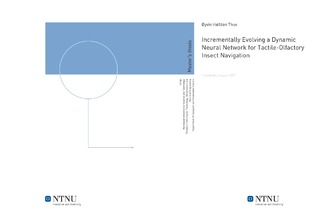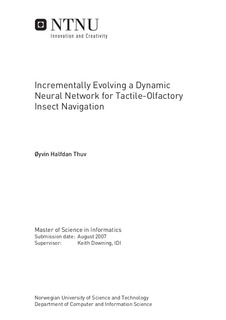| dc.contributor.advisor | Downing, Keith | nb_NO |
| dc.contributor.author | Thuv, Øyvin Halfdan | nb_NO |
| dc.date.accessioned | 2014-12-19T13:32:04Z | |
| dc.date.available | 2014-12-19T13:32:04Z | |
| dc.date.created | 2010-09-03 | nb_NO |
| dc.date.issued | 2007 | nb_NO |
| dc.identifier | 347573 | nb_NO |
| dc.identifier | ntnudaim:1434 | nb_NO |
| dc.identifier.uri | http://hdl.handle.net/11250/250600 | |
| dc.description.abstract | This Masters thesis gives a thorough description of a study carried out in the Self-Organizing Systems group at the NTNU. Much {AI research in the later years has moved towards increased use of representationless strategies such as simulated neural networks. One technique for creating such networks is to evolve them using simulated Darwinian evolution. This is a powerful technique, but it is often limited by the computer resources available. One way to speed up evolution, is to focus the evolutionary search on a more narrow range of solutions. It is for example possible to favor evolution of a specific ``species'' by initializing the search with a specialized set of genes. A disadvantage of doing this is of course that many other solutions (or ``species'') are disregarded so that good solutions in theory may be lost. It is therefore necessary to find focusing strategies that are generally applicable and (with a high probability) only disregards solutions that are considered unimportant. Three different ways of focusing evolutionary search for cognitive behaviours are merged and evaluated in this thesis: On a macro level, incremental evolution is applied to partition the evolutionary search. On a micro level, specific properties of the chosen neural network model (CTRNNs) are exploited. The two properties are seeding initial populations with center-crossing neural networks and/or bifurcative neurons. The techniques are compared to standard, naive, evolutionary searches by applying them to the evolution of simulated neural networks for the walking and control of a six-legged mobile robot. A problem simple enough to be satisfactorily understood, but complex enough to be a challenge for a traditional evolutionary search. | nb_NO |
| dc.language | eng | nb_NO |
| dc.publisher | Institutt for datateknikk og informasjonsvitenskap | nb_NO |
| dc.subject | ntnudaim | no_NO |
| dc.subject | MIT informatikk | no_NO |
| dc.subject | Kunstig intelligens og læring | no_NO |
| dc.title | Incrementally Evolving a Dynamic Neural Network for Tactile-Olfactory Insect Navigation | nb_NO |
| dc.type | Master thesis | nb_NO |
| dc.source.pagenumber | 119 | nb_NO |
| dc.contributor.department | Norges teknisk-naturvitenskapelige universitet, Fakultet for informasjonsteknologi, matematikk og elektroteknikk, Institutt for datateknikk og informasjonsvitenskap | nb_NO |

